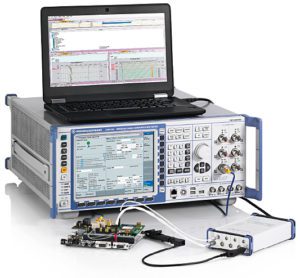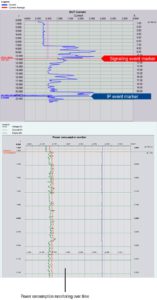New instrumentation simplifies the task of examining how wireless applications behave during periods of both high and low power consumption.
Tom Bifiato, Rohde & Schwarz America
Countless devices use cellular platforms to connect and exchange data. Machine-to-Machine (M2M) and device-to-device (D2D) communication systems all use cellular networks via GSM and GPRS.

M2M and D2D communication platforms are facilitating Internet of Things (IoT) applications. The exponential growth of M2M, D2D and the Internet of Things (IoT) are significant factors driving the ongoing 5G discussion. In addition, new M2M, D2D and IoT applications can cause significant signaling loads in the cellular network, even with apps transmitting only a small amount of user data. As a result, device designers face many challenges associated with quantifying the power consumption caused by applications running on the device under test.
Advanced test and measurement equipment is essential to helping designers better understand the power consumption and battery lifetime performance parameters that affect a user’s quality of experience.
It’s become a truism that much of the IoT infrastructure will use wireless technologies to communicate in the cloud. However, the current 4G cellular technology will soon be unable to support IoT applications. Present-day 4G systems rely on orthogonal frequency division multiple access (OFDMA), which does not provide enough spectrum efficiency for 5th-generation cellular technology (5G).
New 5G networks will boost the network-level data rate up to 20 Gbps (10-20 times the peak data rate in 4G); increase the user-experienced data rate up to 1 Gbps (100 times the user-experienced data rate in 4G); expand bandwidth support 1,000x that of current 4G technology; reduce end-to-end latency to 1 msec (one-fifth of the latency in 4G); and improve overall coverage.
Lower power consumption will be important for 5G IoT networks. The goal is to give 5G components such as wireless modems a battery life of ten years or more. This extended battery life demands more thorough testing of device power consumption and battery lifetime performance.
Common to all IoT scenarios is the use of real-time data from connected “things.” Some of this data will be through D2D connections, where D2D is a wireless standard in LTE-A for direct communication between user equipment in relatively close proximity. (An example of D2D might be two nearby cell phones communicating with each other but without having to go through a cell tower to do it.)
D2D will facilitate interoperability between critical public safety networks and commercial networks, allowing authorities to realize, for example, out-of-network-coverage or communicate during network outages as might arise during a natural disaster. D2D also has commercial benefits. Direct communication between mobile and nearby devices improves spectrum utilization, data throughput, and energy efficiency, all while enabling peer-to-peer and location-based applications and services.
M2M and IoT devices often work with more than one wireless technology, including those following

cellular and non-cellular standards. Some applications requiring global coverage and mobility will focus on cellular technologies, especially on LTE-M and NB-IoT (narrow band-IoT). But the majority of devices will use non-cellular wireless technologies such as Bluetooth, Wi-Fi, zigbee, Thread, EnOcean, SIGFOX, LoRa and others operating in unlicensed ISM/SRD bands.
Because of the sheer number of applications defined within the IoT, engineers must deliver on a wide range of requirements and capabilities. Many applications, such as surveillance cameras, have high uplink data requirements with little or no handover. Fleet management is the opposite, requiring low data transmission with frequent handovers. Smart metering involves supporting a vast number of devices with a small amount of uplink and handover for each device.
IoT devices must be supported in diverse environments ranging from offices and homes to Alaskan pipelines, and everything in between. All these applications need low power consumption and long operating lifetimes. Power efficiency is critical as many IoT devices must operate for years at a time from energy harvesting sources or a single battery.
More and more IoT applications run on smartphones. Features such as DRX (a power saving mode in LTE) should greatly improve smartphone power consumption, but the application behavior must be tested and characterized in a controlled network environment.
Tests used for characterizing M2M, D2D and IoT device applications are diverse. For example, in combined user experience tests, synchronized markers show the IP throughput and current drain at a glance. During analysis, event markers help the user optimize IP throughput and battery life.

New test and measurement equipment developed for these devices not only must collect power supply samples, but also display the current drain on the phone over time. Specific signaling trigger events (e.g. LTE attach or IMS registration) can be implemented, providing more details (i.e. more samples). These typically are displayed in a current-drain diagram. The current drain diagram is also correlated to events at the IP level by using IP traffic analysis, which indicates which app or IP flow impacts the battery lifetime the most.
Test setups can also be extended to include an audio analyzer. It is then possible to monitor smartphone power consumption by establishing a VoLTE call, and to measure audio quality with and without DRX.
It is important to note that test automation software, like the R&S CMWrun, will execute remote control test sequences for wireless equipment. For testing purposes, software engines based on the execution of test DLLs (plug-in assemblies) are preferred over similar capabilities built into hardware. The reason is this type of software architecture allows test personnel to configure test sequences without having to know how to remotely control the instrument. It also provides flexibility when configuring parameters and limits of the test items that the package covers.
A software tool called R&S CMWrun monitors the most important user-experience parameters — such as power consumption and battery lifetime — in parallel with the data throughput. The power consumption parameters are correlated to events at the IP level, using IP analysis measurements. The resulting analysis can indicate which specific application or IP flow impacts battery life.
There are also test instruments specifically optimized to measure parameters on wireless devices. One is the R&S CMW500. It includes a general-purpose RF power meter and CW generator with list modes for fast calibration of wireless devices. Also included is a vector signal analyzer (VSA) for transmitter verification with facilities for fast verification of wireless devices. A vector signal generator (VSG) helps measure receiver parameters. And reference RF power measurements take place through use of a special power sensor.
All in all, M2M, D2D and IoT communication designs and protocols will bring challenges for low power consumption. Better understanding of power consumption will help engineers devise IoT devices that optimize battery life.
References
Rohde & Schwarz America

Leave a Reply
You must be logged in to post a comment.